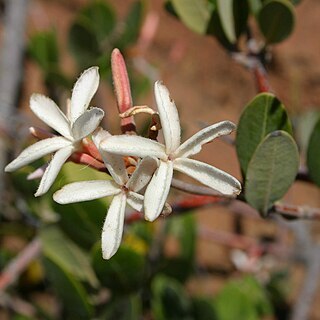Much branched low growing or scandent shrub, to 3 m high, often forming a dense bush. Stems with many small, often raised lenticels, fine rusty hairs when young, older stems glabrescent. Leaves 22-35 x 10-18 mm, midrib shallowly channeled above, secondary veins, 1.5-3.0 mm apart, spreading at almost right angles to the mid-rib, pubescent on both surfaces when young, becoming glabrescent with age; apex rounded; base obtuse; petiole 3-7 mm long. Inflorescences in terminal panicles, 24-100 mm long, ending in 1-3-flowered cymes, on short, spreading or recurved branches which often act as tendrils, rusty pubescent to glabrescent; bracts small, triangular, with white or rusty hairs, sometimes with white hairs at tips. Calyx 2.5-5.0 x 2.0-3.0 mm; tube 1-3 mm long; lobes 2-4 mm long. Corolla tube 5-10 mm long, swollen to 1-2 mm wide slightly above base, then narrowing again before widening to 1-2 mm at throat; lobes white, 6-16 x 3-5 mm. Androecium anthers c.1.5-2.5 mm long; filaments c. 1-1.5 mm long. Gynoecium stigma at base of anthers, apex bifid; style cylindrical, c. 1.5 mm long; ovary globose, pubescent; ovules small, numerous. Fruit globose to pear-shaped; densely and finely reddish tomentose when young, yellowish when ripe; 35-50 mm in diameter. Seeds few to many.
A low sprawling shrub. It grows 2 m high. It has milky sap. The leaves are leathery and narrowly oval. They are dark green and shiny. The flowers are white or pink. The fruit are round or pear shaped. They are covered with a fine coating. The skin is tough. Young fruit exude a white latex. The fruit are reddish-yellow when ripe. There can be a few to many seeds.
Scandent shrub, 1-2 m or up to 5 m high. Leaves 25-35 (rarely 45) mm long; secondary nerves spreading at right angles, distinct, 2.5-3.5 mm apart. Corolla tube 6-14 mm long, lobes 11-24 mm long; pubescence on corolla tube rusty red. Flowers white.
Corolla tube 7–10 mm. long, slender, slightly inflated just below the middle, outer surface densely ferrugineous-pubescent above the level of the calyx, the indumentum continuing onto the lobes, inner surface of tube pubescent in the upper half.
Venation characteristic, with lateral nerves running straight to margin and joined in a looped submarginal vein, but veins relatively obscure because of the thick leaf texture.
Upper leaf surface mat, puberulous, midrib slightly impressed, other nerves level; lower surface mat, paler than above, subglabrous to puberulous, all nerves slightly raised.
Leaves coriaceous; petiole 3–6 mm. long; lamina 1·4–3·8 x 0·8–1·6 cm., elliptic to oblong, apex rounded to obtuse, without acumen, base cuspidate, sometimes fairly tapered.
Inflorescences terminal panicles in which the few branches end in 1–3-flowered cymes; flowers also present, solitary and sessile, in axils of leaf-pair below the peduncle.
Corolla lobes 7–17 mm. long, 1–1·5 or more times as long as tube, lobes narrowly obovate, glabrous on inner surface, ± pubescent externally, shortly ciliate.
Calyx 4–5 mm. long, lobes narrowly linear, rounded at apex, united at base, dorsally densely ferrugineous appressed-pubescent.
Much-branched twiggy shrub, creeping along the ground or growing to 3 m., with stems farinose-puberulous.
Stamens inserted c. 2·5 mm. from the base of the tube; anthers subsessile, c. 1·5 mm. long.
Ovary c. 0·75 mm. long, globose, pubescent.
Style, clavuncle and stigma c. 2 mm. long.
Fruit subglobose, up to 5 cm. in diameter.
Flowers white, sweet-scented.
Seeds 10–12 mm. long.

